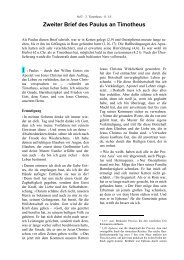You also want an ePaper? Increase the reach of your titles
YUMPU automatically turns print PDFs into web optimized ePapers that Google loves.
freezing. But this is impractical, and is technically<br />
impossible for signals having the same strength<br />
as the (statistical) noise. A certain trick helps –<br />
transmit the signal on two separate channels and<br />
subsequently combine them. In this way the random<br />
noise fluctuations in each partially cancel<br />
each other out, resulting in an appreciable reduction<br />
in noise.<br />
This method is also employed in the eye. In sensory<br />
<strong>organs</strong> and nerve cells, “noise” is not so<br />
much a result of fluctuations in electron density,<br />
but is caused by fluctuations in the voltage on<br />
the interfaces between sensory and nerve cells.<br />
The Creator made our optic cells as sensitive as<br />
physically possible. As mentioned, one single<br />
light quantum (photon), the smallest physical<br />
unit of light, is sufficient to cause an electric<br />
impulse in an optic cell. Any possible illusion<br />
which might be caused by “noise”, is eliminated<br />
as follows:<br />
Several hundred rods, the most highly sensitive<br />
cells, are connected to only one nerve cell. These<br />
special nerve cells only transmit an impulse if a<br />
sufficiently strong signal has been received from<br />
at least four or five optic cells within a certain<br />
time period, about 0.02 seconds. This means that<br />
the individual optic cells are as sensitive as at all<br />
physically possible, but the nervous system only<br />
transmits signals when several impulses arrive<br />
more or less at the same moment, after a certain<br />
summation period. Thus the maximum possible<br />
sensitivity only comes into play when the light<br />
stimulus arises virtually simultaneously from<br />
receptor cells spread over a sizeable area, and not<br />
from just a single point. Random “noise“ fluctuations<br />
would arise at different times in each cell,<br />
so are never transmitted.<br />
Visual acuity: Visual acuity (sharpness), the ability<br />
to resolve objects, is very important in the<br />
assessment of vision. Under good illumination a<br />
normal eye can distinguish between two points if<br />
the incident light rays make an angle of 1 minute<br />
(1’ = 1/60 degree).<br />
Adaptation (Latin: adaptio = adjustment, especially<br />
that of sensory <strong>organs</strong> to the prevailing<br />
16<br />
conditions): <strong>Our</strong> eyes are able to process bright<br />
and dim light over a wide range. At night we can<br />
observe dim stars, and we can also adapt to the<br />
glaring intensity of bright sunlight reflected from<br />
snow and ice. This amazing adaptability of the<br />
eye spans an immense range – a factor of 1 to<br />
1 million million!<br />
Colour perception: We would have missed<br />
something wonderful if we could not see colours!<br />
Colours may bring joy, and can even affect our<br />
moods. They contribute to happiness and affect<br />
our state of mind. Colours fascinate all of us, not<br />
just artists and fashion designers.<br />
Colours can be characterised by three aspects,<br />
namely hue, brightness, and saturation (= the<br />
degree of admixture with white). <strong>Our</strong> eyes can<br />
distinguish 300 different hues or shades of<br />
colour, and if, in addition, the brightness and saturation<br />
are varied as well, several million possible<br />
colour values can be distinguished. The brightness<br />
of a colour is determined by the strength of<br />
illumination, and the saturation.<br />
In our eyes it is only the cones which can detect<br />
colours. The chemical involved is called rhodopsin<br />
(Greek rhodon = a rose), or visual purple. It consists<br />
of protein molecules (comprising approximately<br />
350 amino acids), including the so-called<br />
retinal which colours the rhodopsin. Retinal also<br />
makes the rhodopsin sensitive to light, similar to<br />
the way a detonator makes a cartridge sensitive<br />
to being struck by a firing pin. The rhodopsin of a<br />
cone cannot absorb all the light quanta (photons)<br />
which strike it; it “selects” quanta of a certain<br />
size (wavelength). It will capture most or all of<br />
such quanta, but will also capture one out of ten<br />
to one out of fifty of those which are exactly<br />
double or half the preferred size. However, each<br />
photon captured has the same effect, regardless<br />
of the wavelength.<br />
There are three types of cones, each preferring<br />
a specific, optimal quantum size. They are known<br />
respectively as red-, green-, or blue-sensitive<br />
cones, according to the optical pigments and the<br />
preferred quantum size (wavelength of the incoming<br />
photons of light). But all this still does
















